Overview
Securing business loans in Australia requires a solid understanding of various loan types, a thorough assessment of financial needs, and effective navigation of the application process. This article outlines essential steps for small business owners, highlighting the necessity of:
- Preparing a comprehensive business plan
- Maintaining a strong credit score
- Selecting the right lender
These actions significantly enhance the likelihood of loan approval and successful financial management.
Are you ready to take the next step in securing the funding your business needs? By understanding the landscape of business loans, you can position yourself for success. A well-prepared business plan not only demonstrates your vision but also instills confidence in potential lenders.
Furthermore, maintaining a good credit score is crucial. It serves as a reflection of your financial responsibility and can greatly influence the terms of your loan. In addition, choosing the right lender is vital; it can mean the difference between a smooth application process and unnecessary hurdles.
By following these steps, you can enhance your chances of securing a loan that aligns with your business goals. Take action today and set your business on the path to financial success.
Introduction
In the dynamic landscape of small business financing, grasping the nuances of business loans is essential for entrepreneurs eager to fuel their growth and tackle operational challenges.
With a variety of loan types available in Australia—ranging from secured and unsecured loans to lines of credit and equipment financing—each option offers distinct advantages tailored to diverse business needs.
Given the pivotal role small enterprises play in the economy, the capacity to secure appropriate funding can profoundly influence their success.
This article explores the essentials of business loans, providing insights into the application process, necessary documentation, and strategies for overcoming common hurdles.
By doing so, it ensures that small business owners are well-equipped to make informed financial decisions.
Understanding Business Loans for Small Enterprises
Business financing serves as a vital financial tool, enabling small enterprises to fund operations, drive growth, or undertake specific projects. In Australia, business loans can be categorized into several types of financial aids, each tailored to meet distinct organizational needs. The primary types include:
- Secured Loans: These loans necessitate collateral, such as property or equipment, which can lower interest rates and improve approval chances. They are particularly suited for substantial investments, like purchasing machinery or real estate.
- Unsecured Financing: In contrast to secured options, these loans do not require collateral, making them accessible for enterprises lacking significant assets. However, they often carry higher interest rates and are ideal for smaller amounts or short-term needs.
- Lines of Credit: This flexible financing option allows enterprises to draw funds as necessary, making it perfect for managing cash flow fluctuations or unexpected expenses. Interest is only paid on the drawn amount, providing cost efficiency.
- Term Financing: Typically used for specific projects or investments, term financing is provided for a fixed period with a set repayment schedule. These loans can be secured or unsecured and are frequently utilized for expansion or major purchases.
Understanding these distinctions is crucial for small enterprise owners aiming to select the most suitable financing option for their unique circumstances. As we look toward 2025, the landscape of financial assistance in Australian business loans is trending upward, with enterprises increasingly borrowing to support expansion efforts. Notably, the typical financing amounts for acquiring established enterprises reached approximately $261,944, while funding for machinery and equipment averaged around $181,434.
Moreover, small enterprises play an essential role in the Australian economy, significantly contributing to employment and economic growth, often supported by business loans. Successful financing applications often hinge on clear planning and demonstrating expected returns on investment (ROI). At Finance Story, we focus on developing refined and highly personalized cases to present to financiers, ensuring that your funding proposal meets the elevated standards of financial organizations.
We provide access to a comprehensive range of lenders, including high street banks and innovative private lending panels, tailored to your specific circumstances, whether you are looking to purchase a warehouse, retail premise, factory, or hospitality venture. Phil Collard, a financing expert, emphasizes that 'the appropriate funding facility can be a very powerful tool to accelerate growth, so be sure to have your plans clearly mapped out.'
Recent case studies underscore the importance of responsive customer relations in the lending process. For instance, PMA's commitment to transparent communication and a straightforward lending process has proven effective in assisting clients navigate their financing options, enhancing reliability and trust.
As we advance through 2025, staying informed about current trends and statistics in commercial loans is essential for small enterprises. This knowledge not only aids in making informed decisions but also empowers organizations to leverage financing effectively for sustainable growth. Additionally, it is important to recognize that sectors such as Agriculture, Forestry and Fishing, and Retail Trade have experienced declines of 1.3% and 1.4% respectively in 2023/24, which may impact the lending landscape and the opportunities available for small enterprises.
Furthermore, refinancing alternatives are available to assist enterprises in adjusting their current financial obligations to meet changing requirements, ensuring ongoing support for growth and advancement.
Assessing Your Financial Needs and Loan Requirements
Conducting a comprehensive evaluation of your funding requirements is crucial before applying for Australia business loans. Begin by thoroughly analyzing your current monetary situation, which includes evaluating cash flow, existing debts, and future economic projections. This foundational step allows you to understand your financial health and identify any potential challenges.
Next, clarify the specific purpose of the financial assistance. Are you looking to expand your operations, purchase new equipment, or cover operational costs? Defining the purpose of the borrowing will help you calculate the exact amount needed, ensuring that you are not overextending your finances.
For instance, in 2022, Australian small enterprises raised approximately $70 million through 91 crowd-sourced equity funding deals, highlighting the diverse funding avenues available.
Grasping the typical borrowing figures for small enterprises in Australia can also provide important context for Australia business loans. As of 2025, small enterprises typically pursue Australia business loans ranging from $10,000 to $500,000, depending on their specific needs and growth strategies. This range highlights the significance of customizing your loan request to your unique circumstances.
Moreover, consider the broader landscape of small enterprise financing, particularly Australia business loans. Statistics reveal that 60% of businesses in Australia that do not secure Australia business loans fail within their first three years, with 20% closing their doors in the first year. Common reasons for these failures include poor management and inadequate market research, underscoring the importance of a well-thought-out monetary strategy when seeking Australia business loans.
Developing a clear exit strategy can also mitigate potential financial detriments, reinforcing the importance of strong leadership and market understanding. As Jon Sutton, CEO of ScotPac, states, "We really need the SME sector to be firing on all cylinders," emphasizing the critical role of small enterprises in the economy.
Additionally, working with experts like Finance Story can significantly enhance your chances of securing the right Australia business loans. They focus on developing refined and highly personalized proposals to present to banks, ensuring that your financing request meets the elevated expectations of lenders. Brokers are encouraged to support SME clients during these challenging times, as they can provide valuable insights and assistance in navigating the financing process.
Consulting with financial advisors can further enhance your understanding of your Australia business loans requirements. Their guidance can help you navigate the complexities of the lending landscape, ensuring that you select the most suitable financing options for your objectives. By taking these steps, you can position your enterprise for success while minimizing the risks associated with borrowing.
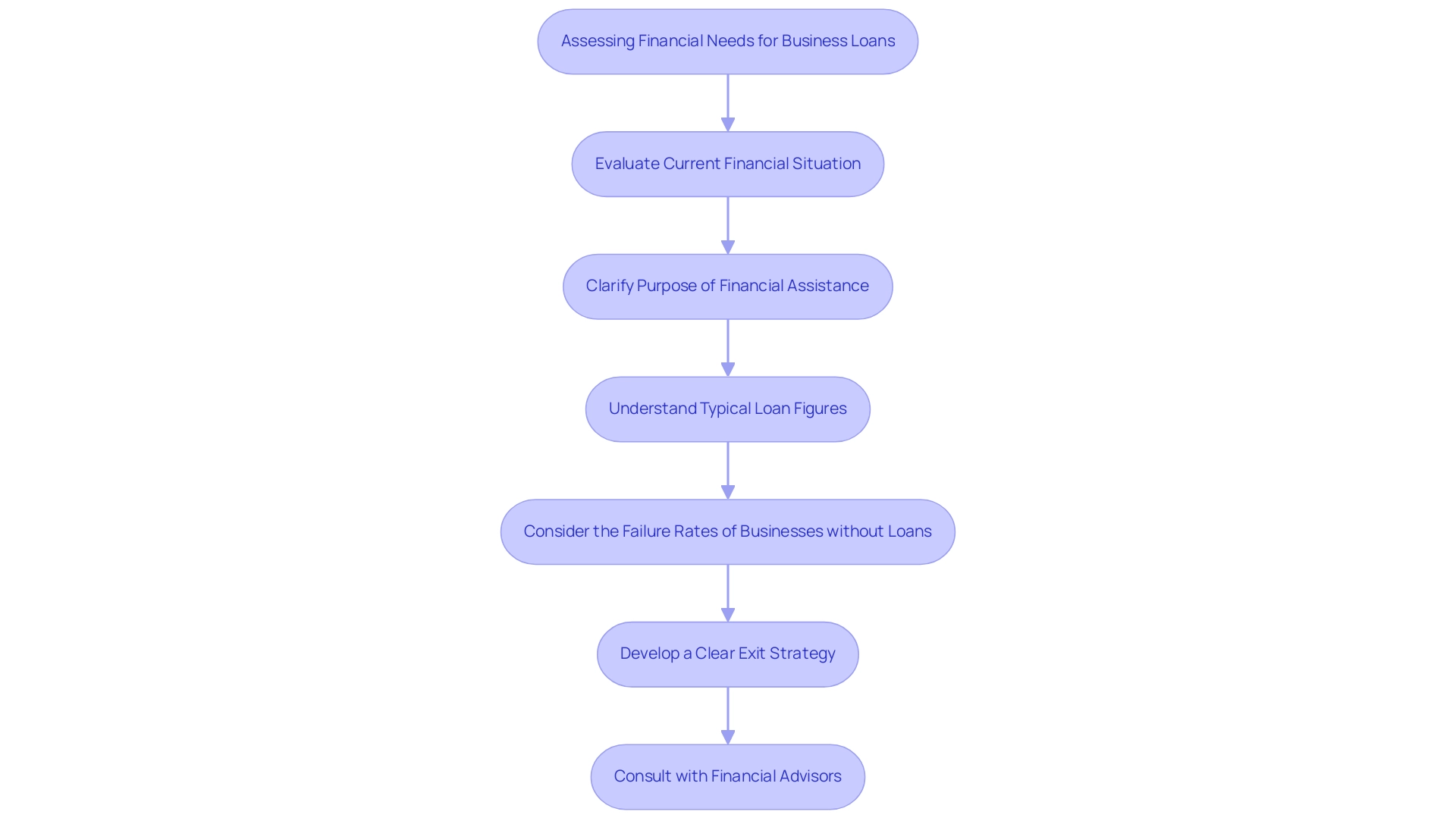
Exploring Different Types of Business Loans Available
Small enterprises in Australia can access a diverse array of business loans, each tailored to meet specific financial needs. Understanding these options is crucial for making informed decisions. Here’s a closer look at the primary types of business loans available in 2025:
- Term Loans: These loans provide a lump sum borrowed for a fixed period, typically ranging from one to five years. They are ideal for significant investments, such as purchasing property or expanding operations. The average interest rate for Australian business loans currently hovers around 6.5%, depending on the lender and the borrower's creditworthiness.
- Lines of Credit: Offering flexibility, lines of credit allow companies to withdraw funds as needed, making them perfect for managing cash flow fluctuations. This type of financing can be especially advantageous for seasonal enterprises or those facing unexpected costs. Interest rates for lines of credit can vary widely, often starting at around 7%.
- Equipment Financing: Specifically designed for purchasing equipment, these loans use the equipment itself as collateral. This means that companies can secure funding without needing to provide additional assets. The current average interest rate for equipment financing is approximately 5.5%, making it an appealing choice for companies looking to upgrade or expand their operational capabilities.
- SBA Financing: Supported by the government, Small Business Administration (SBA) financing provides favorable terms, including lower down payments and extended repayment periods, which can be beneficial for those seeking Australian business loans. These financial aids are especially beneficial for startups and small enterprises that may find it challenging to obtain conventional funding. While the approval process can be lengthy, the benefits often outweigh the wait.
- Invoice Financing: This innovative solution enables companies to borrow against outstanding invoices, providing immediate cash flow. It is particularly useful for companies that experience delays in receiving payments from clients. The cost of invoice financing can vary, but it typically involves a fee based on the invoice amount.
Each type of credit, such as Australian business loans, comes with its own eligibility criteria, interest rates, and repayment terms. For instance, Australian business loans typically require a solid credit history and a clear plan, while lines of credit may be more accessible for enterprises with fluctuating income.
Understanding the repayment criteria is crucial when considering these financing options. Lenders will evaluate the strength of your company's profits and your capacity to make repayments without economic strain. They frequently require a thorough plan and cash flow forecasts to ensure that your enterprise can sustain itself and meet its obligations, particularly during slower months.
In a recent case study titled "Steps to Secure Small Business Financing Successfully," it was emphasized that assessing financial needs and choosing the right type of funding, including Australian business loans, are critical steps in the application process. This aligns with expert views, such as that of Phil Collard, a lending specialist, who remarked, "The right loan facility can be a very powerful tool to accelerate growth, so be sure to have your plans clearly mapped out, including expected ROI."
With over 25 years of experience in improvement and technology implementation, Finance Story is well-positioned to guide small enterprise owners through the complexities of securing financing. As the landscape of financing continues to evolve, staying informed about the latest updates and trends is crucial for small enterprise owners. With the average credit rating of personal borrowing individuals in Australia steadily rising, financial institutions are becoming more inclined to provide competitive rates for Australian business loans, creating a favorable moment for enterprises to explore their funding options.
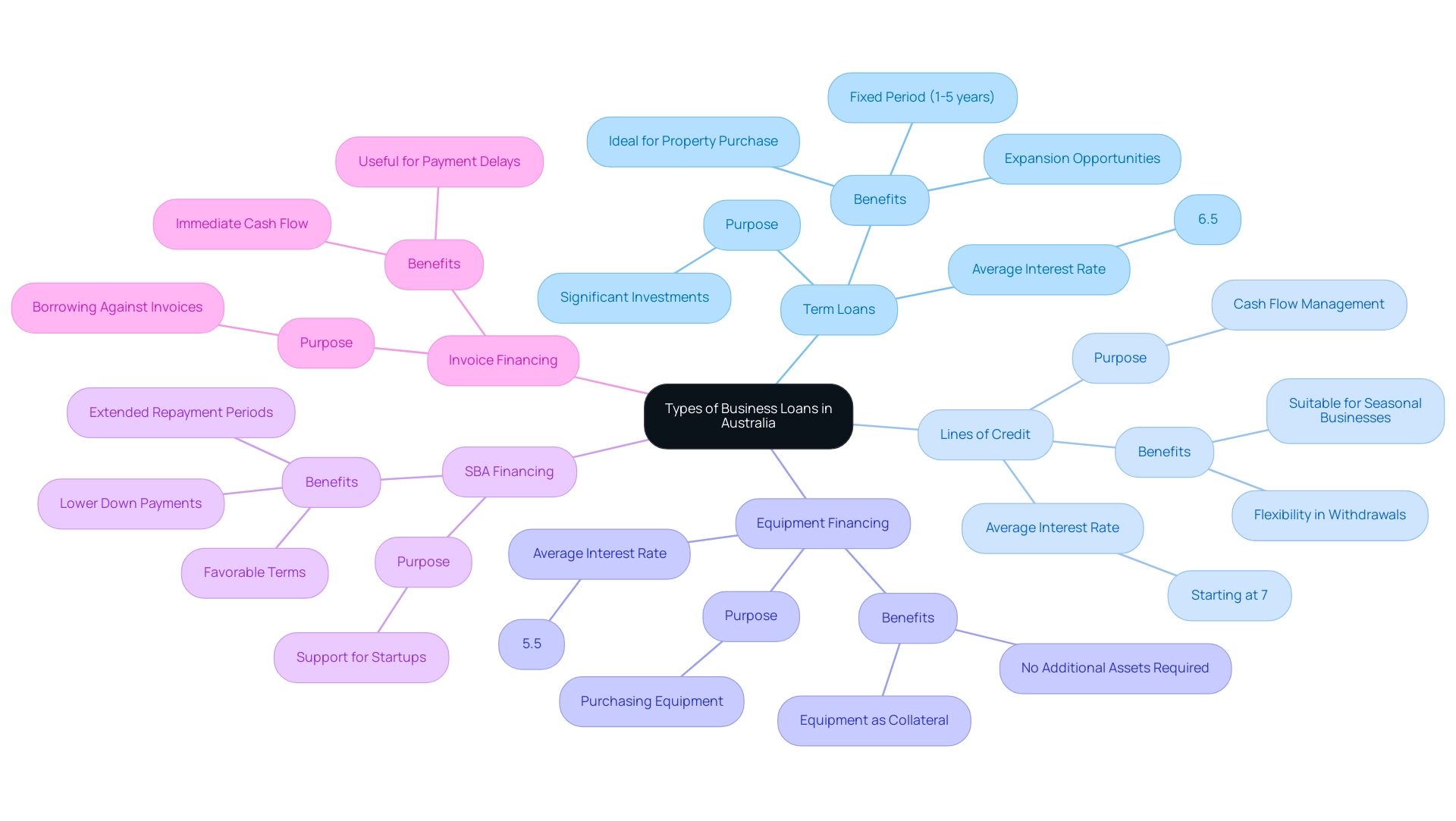
Navigating the Business Loan Application Process
Navigating the business funding application process is essential for small business owners seeking financial support through Australian business loans. Here are the key steps to ensure a successful application:
- Research Lenders: Begin by identifying potential lenders that specialize in the financing you require. Comparing their terms, interest rates, and customer reviews is crucial to finding the best fit for your needs. Notably, in 2023, personal borrowing demand in Western Australia rose by 10% year-on-year, underscoring the competitive landscape of lending options available.
- Prepare Your Plan: A well-structured plan is vital. It should clearly outline your business model, financial projections, and the specific purpose of the loan. This document serves as a roadmap for your enterprise and demonstrates to financiers that you possess a clear strategy for success. As business finance writer Isabelle Comber emphasizes, "A comprehensive business plan is essential for securing funding, as it showcases your vision and preparedness to investors."
- Gather Documentation: Compile all necessary documents to support your application. This typically includes financial statements, tax returns, and proof of income. Having these documents organized and readily available can streamline the application process.
- Submit Your Application: Complete the financial institution's application form meticulously, ensuring that all required documentation is included. A thorough application can significantly enhance your chances of approval.
- Follow Up: After submitting your application, it is essential to follow up with the financial institution. Checking the status of your application and proactively providing any additional information they may request can demonstrate your commitment and help expedite the process.
Understanding the typical duration required for financial approval for Australian business loans is also advantageous; as of 2025, this usually spans from a few days to several weeks, depending on the lender and the complexity of your application. Additionally, statistics indicate that a well-prepared application for Australian business loans can significantly improve success rates, with projections suggesting success rates for business financial applications in Australia will be around 75% in 2025, making thorough preparation essential.
A significant case study is the initiative by Indigenous Business Australia (IBA) in February 2023, which broadened its financial offerings to support economic development in Indigenous communities. By offering low-interest funding with adaptable repayment conditions, IBA seeks to improve monetary access and encourage fiscal literacy, addressing the unique challenges faced by these communities. This example highlights the importance of customized financial solutions in navigating the commercial funding landscape.
Furthermore, Finance Story's reputation for professionalism and thorough understanding of the finance sector positions it as a reliable ally for small enterprises, with access to a diverse portfolio of lenders, including a dedicated lending partner in the UK for expat financing.
To further assist you in navigating your financing options, consider scheduling a free personalized consultation with Finance Story's Head of Funding Solutions, Shane Duffy. This 30-minute meeting will enable you to discuss your needs and goals, ensuring you receive tailored financial strategies that align with your objectives.
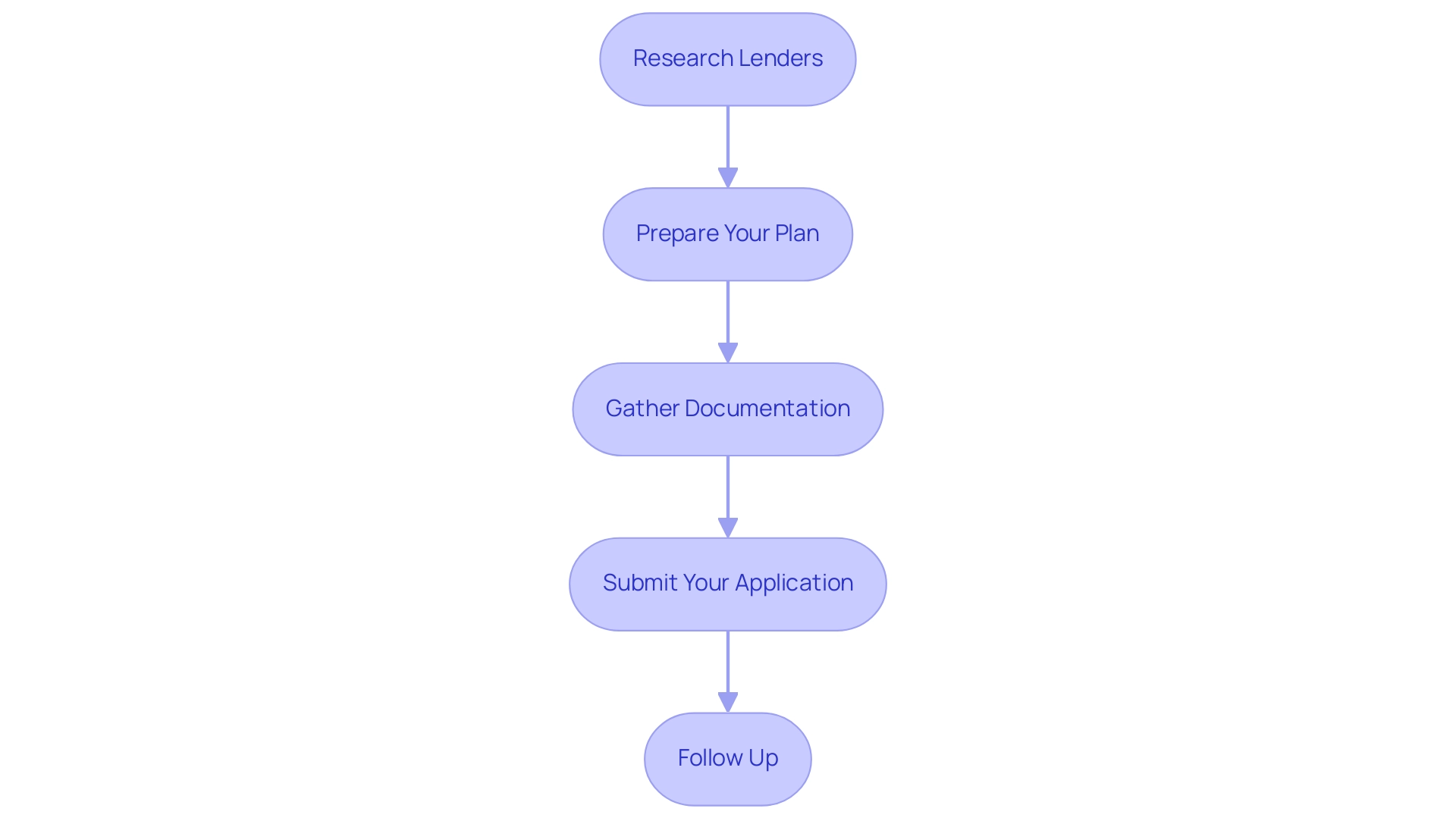
Essential Documentation for Business Loan Applications
When seeking Australia business loans, preparing a thorough collection of documentation to support your application is essential. The following are vital documents typically required:
- Business Plan: A well-structured business plan outlining your objectives, strategies, and how the loan will facilitate your growth is crucial. This document serves as a guide for your enterprise and demonstrates to financiers your readiness and vision.
- Financial Statements: Recent financial statements, including profit and loss statements, balance sheets, and cash flow statements, are necessary to provide a clear picture of your company's financial health. These documents assist financial institutions in evaluating your capacity to repay the loan and are essential for developing customized loan proposals that address the unique requirements of your commercial property investment.
- Tax Returns: You will need to submit personal and corporate tax returns for the past two years. This information is critical for lenders to assess your economic history and adherence to tax obligations.
- Identification: Personal identification for all owners and key stakeholders is required to verify identities and ensure accountability.
- Bank Statements: Recent bank statements are essential to demonstrate your cash flow and overall financial stability. Lenders often review these statements to gauge your company's liquidity and operational efficiency.
In 2025, the average number of documents required for loans in Australia has been noted to be around five, reflecting a streamlined approach to the application process. However, ensuring that all documents are accurate and up-to-date is paramount, as this can significantly facilitate a smoother application experience.
The significance of financial statements cannot be overstated; they not only offer insight into your organization's performance but also emphasize your ability to manage finances effectively. According to recent statistics, small businesses in Australia employ over 5.1 million people and constitute 97.2% of all businesses, underscoring their critical role in the economy. However, with a high failure rate of 60% within the first three years, it is essential to approach financial applications with thorough preparation and a clear understanding of the required documentation.
This is especially significant considering that borrowers in the Northern Territory request the lowest average personal amount of $19,168, and the average credit score among personal borrowers in Australia is 801, indicating a competitive credit landscape.
Incorporating expert insights, advisors emphasize that having a complete and organized set of documents can significantly enhance the likelihood of a successful application for Australia business loans. Shaun McGowan, founder of Money.com.au, states, "He's determined to assist individuals and enterprises in paying as little as possible for financial products, through education and creating world-class technology." By prioritizing these essential documents, small enterprise owners can navigate the complexities of securing Australia business loans more effectively, especially when collaborating with experts like Finance Story who specialize in creating polished and highly individualized cases for obtaining the right financing solutions.
Additionally, Finance Story provides access to a diverse array of financial institutions, including high street banks and innovative private lending panels, ensuring that you can find the right financing option for your needs, whether you are purchasing a warehouse, retail premise, factory, or hospitality venture. Furthermore, refinancing choices are accessible to assist you in adjusting your current commercial financing to satisfy the changing requirements of your enterprise.
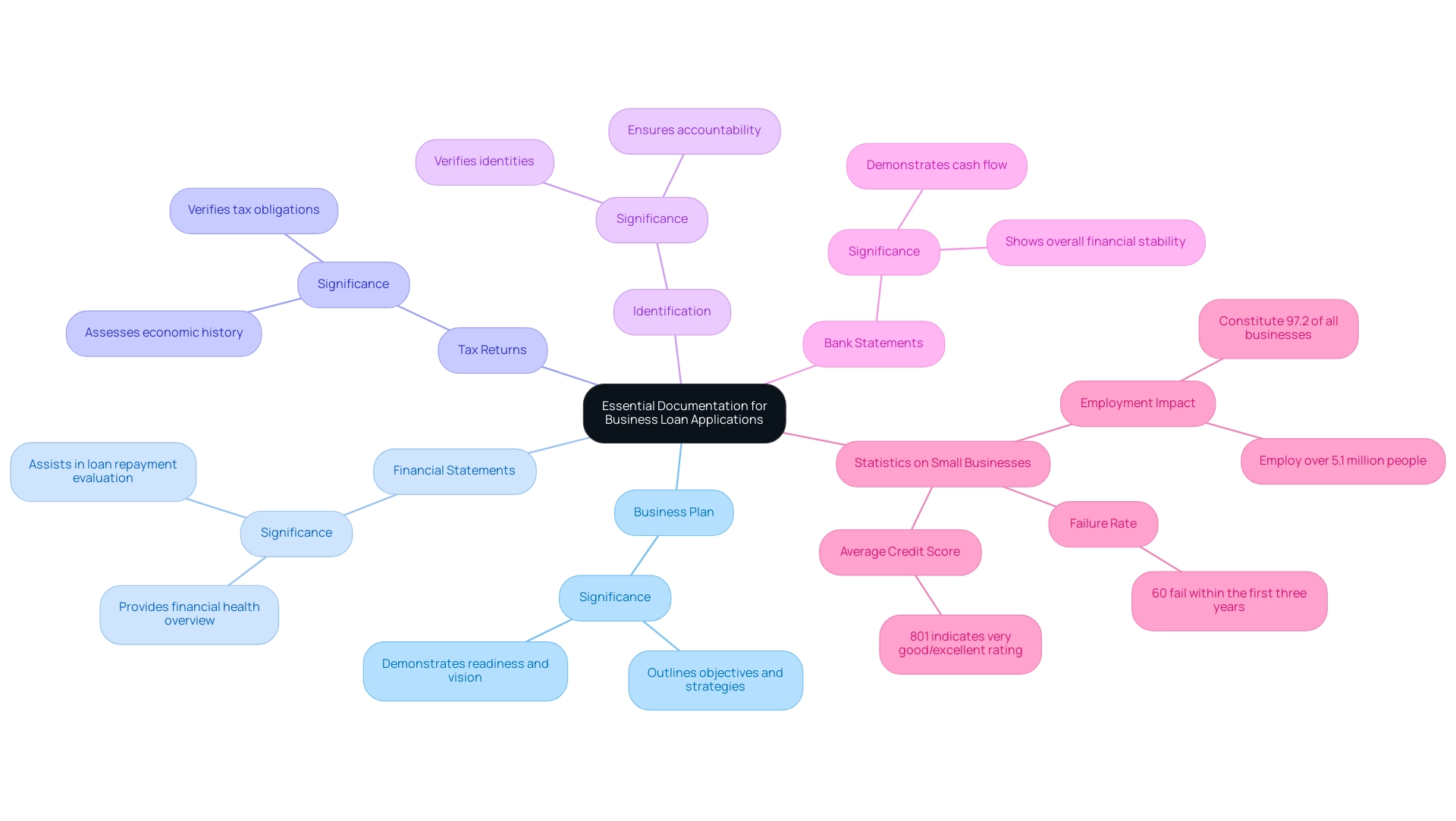
Understanding the Role of Credit Scores in Loan Approval
Credit scores play a pivotal role in the approval process, serving as a key indicator for lenders to evaluate the risk associated with providing funds to an enterprise. A higher credit score typically signifies lower risk, which can translate into more favorable terms, including reduced interest rates and increased amounts. In 2025, the average credit score for small business owners in Australia is projected to be around 650, underscoring the importance of maintaining a robust credit profile to enhance their chances of securing business loans in Australia.
To elevate your credit score and secure better loan terms, consider implementing the following strategies:
- Ensure timely payments on all existing debts, as payment history significantly impacts your score.
- Reduce outstanding balances on credit accounts to lower your credit utilization ratio, a critical factor in credit scoring.
Avoid applying for multiple forms of credit simultaneously, as each application can lead to a hard inquiry, potentially diminishing your score.
Financial experts emphasize that small enterprise owners should routinely monitor their credit reports for inaccuracies and take proactive steps to correct any discrepancies. This vigilance not only aids in enhancing credit scores but also boosts the likelihood of approval for business loans in Australia. As Anna Bligh, CEO, noted, "Banks are closely monitoring the developing situation along the east coast and are putting in place arrangements to support customers in affected areas," highlighting the current lending environment.
Case studies reveal that companies with improved credit ratings often experience a more seamless approval process, securing superior conditions that foster growth and expansion. For instance, Finance Story's innovative approach, which involves crafting refined financial cases for banks and providing access to a diverse array of private lenders, can significantly assist small enterprise owners in enhancing their credit ratings and obtaining better funding conditions. Finance Story specializes in various commercial properties, including warehouses, retail premises, factories, and hospitality ventures, ensuring tailored solutions for your financing needs.
As one satisfied client, Natasha B. from VIC, stated, "We are finished with the constant worry. Once again, thank you so much for being a part of our journey." By understanding and actively managing credit scores, small enterprise owners can position themselves advantageously in the competitive landscape of financing, including business loans in Australia and refinancing options to meet their evolving needs.

Overcoming Common Challenges in Securing Business Loans
Securing Australia business loans presents several challenges that small business owners must navigate effectively. Understanding these obstacles and employing strategic solutions is crucial for success:
- Poor Credit History: A low credit score can significantly hinder your chances of loan approval. To improve your creditworthiness, focus on paying off outstanding debts and ensuring timely payments. This proactive approach can enhance your credit profile before you apply.
- Insufficient Documentation: Lenders require comprehensive documentation to evaluate your monetary health. Prepare all necessary documents, including tax returns, financial statements, and business plans, to avoid delays in the application process. Being organized can streamline your experience and showcase your professionalism to financial institutions.
- High Debt-to-Income Ratio: If your current debt is considerable relative to your income, financial institutions may be hesitant to authorize your credit. Prioritize reducing your debt load before applying. This not only improves your chances of approval but also positions you as a more attractive candidate for financing.
- Absence of Operational History: New enterprises frequently encounter challenges in obtaining financing due to restricted operational history. In such cases, consider alternative financing options, such as microloans or peer-to-peer lending, which may be more accessible. Additionally, seeking smaller loan amounts initially can help establish a credit history with lenders.
By proactively addressing these challenges, you can significantly enhance your chances of securing Australia business loans necessary for your venture's growth and sustainability. Finance Story specializes in creating polished and highly individualized proposals to present to banks, ensuring you have the best chance of approval. With access to a full range of lenders, including high street banks and innovative private lending panels, you can find the right financing solution tailored to your needs, whether you are looking to purchase a warehouse, retail premise, factory, or hospitality venture.
Refinancing options are also available to help meet the evolving needs of your company.
As highlighted in recent statistics, approximately 75 percent of established small enterprises with employees continue to thrive four years later, underscoring the importance of securing adequate financing to support long-term success. Moreover, with the construction industry representing approximately 30% of recent company bankruptcies, it is essential for all small enterprises to manage these economic obstacles effectively. Prime Minister Anthony Albanese emphasized this need, stating, "Small enterprises are the backbone of our economy."
We must ensure they have access to fair and sustainable financing options such as Australia business loans. Implementing measures such as stronger regulations for non-bank lenders and promoting financial education can also contribute to a healthier lending environment for small enterprises. Additionally, it is important to note that small enterprises tend to keep a higher share of their total assets as cash compared to large enterprises, reflecting their greater difficulty in accessing external funding.
This emphasizes the urgency of obtaining funding to mitigate risks and support operations.
Selecting the Right Lender for Your Business Needs
Selecting the appropriate financier is crucial for a successful experience with Australia business loans. Consider the following key factors:
- Reputation: Investigate lenders' reputations by examining reviews and testimonials from fellow business owners. A financial institution's track record can significantly influence your borrowing experience, as a strong reputation often correlates with reliability and trustworthiness. For instance, Finance Story has garnered positive testimonials, with clients like Natasha B. from VIC expressing gratitude for their professionalism and support throughout the financing journey, stating, "I will definitely be recommending your business to anyone. We are finished with the constant worry." This deep understanding of the finance sector is crucial when assessing potential creditors.
- Loan Terms: It's essential to compare interest rates, repayment conditions, and associated fees among different financial institutions. Finding a financial institution that offers Australia business loans with terms aligned with your financial strategy is crucial.
- Customer Service: Evaluate the quality of customer service offered by prospective financial institutions. Responsive and knowledgeable support can streamline the application process and address any concerns that may arise, ensuring a smoother experience. Finance Story is known for its bespoke mortgage services, which cater to the unique needs of each client, enhancing the overall customer experience.
- Specialization: Some financial institutions concentrate on particular sectors or categories of credit. Recognizing a financial provider with expertise in your sector can offer customized solutions that more effectively address your requirements. Finance Story sets itself apart with its innovative lending method, providing a varied portfolio of choices adapted to specific situations, including refinancing and obtaining loans for commercial property investments.
Spending time on choosing the appropriate financier can result in a more advantageous borrowing experience, ultimately aiding your company's growth and financial well-being. Successful narratives from small enterprise owners highlight that those who carefully assessed their financing options, such as Australia business loans, often secured better terms and support, reinforcing the importance of this decision. As Jon Sutton, CEO of ScotPac, emphasizes, "We really need the SME sector to be firing on all cylinders," underscoring the need for reliable lending options.
With more than 25 years of experience in enhancing operations and technology integration, Finance Story embodies the knowledge that small enterprise owners should seek in a financial partner.
Managing Your Business Loan After Approval
Once your enterprise funding is approved, effective management becomes crucial for maintaining financial health and ensuring the sustainability of operations. Here are essential strategies to consider:
- Create a Repayment Plan: Develop a detailed repayment schedule that outlines payment amounts and due dates. This proactive approach helps avoid late fees and penalties, ensuring your organization remains in good standing with lenders. Finance Story focuses on creating personalized cases that assist in obtaining appropriate financing terms, making repayment more manageable.
- Monitor Cash Flow: Regularly assess your cash flow to confirm you can meet repayment obligations without compromising your operational budget. A healthy cash flow is vital for sustaining business activities and supporting growth initiatives. With the right refinancing options from Finance Story, you can adjust your loan structure to better fit your cash flow needs.
- Communicate with Your Lender: If you encounter any monetary challenges, it’s important to reach out to your lender promptly. Open communication can lead to possible restructuring options or adjustments to your payment terms, easing monetary pressure. Finance Story's expertise in refinancing can provide the necessary support to navigate these discussions effectively.
- Keep Accurate Records: Maintain meticulous records of all transactions related to borrowing. This practice not only assists in financial planning but also offers a clear record of your management, advantageous for future financing requirements.
Research suggests that small enterprises adopting organized repayment strategies encounter greater success in handling their finances. In fact, effective financial management practices can significantly improve an organization's ability to thrive in a competitive landscape. As observed by economic specialists, "A well-organized repayment strategy is not merely about fulfilling responsibilities; it’s about encouraging a sustainable growth path for your enterprise."
In the context of the broader economic environment, it’s important to note that total labor costs incurred by employers in Australia were $760.9 billion, with private sector labor costs accounting for 77.7% of this total. This statistic emphasizes the financial challenges small enterprises encounter and highlights the significance of efficient funding management, particularly regarding Australia business loans.
Moreover, as Anna Bligh, CEO of the Australian Bankers' Association, stated, "These small enterprises will drive Australia through the crisis, and after it has passed, employ millions of Australians as the economy rebuilds, underlining the necessity of Australia business loans to support their growth." This highlights the essential role of small enterprises in the economy and reinforces the significance of effective financial management.
Finance Story, a Melbourne-based boutique mortgage brokerage, exemplifies how customized financial solutions can help clients manage their finances effectively. They collaborate with a full range of financial institutions, including high street banks and innovative private lending panels, to provide options that suit various circumstances, whether purchasing a warehouse, retail premise, factory, or hospitality venture. Their reputation for professionalism and profound knowledge of the finance sector establishes them as a reliable ally for small enterprises managing the intricacies of funding.
By adopting these strategies, you can cultivate a positive relationship with your lender and position your venture for long-term success.
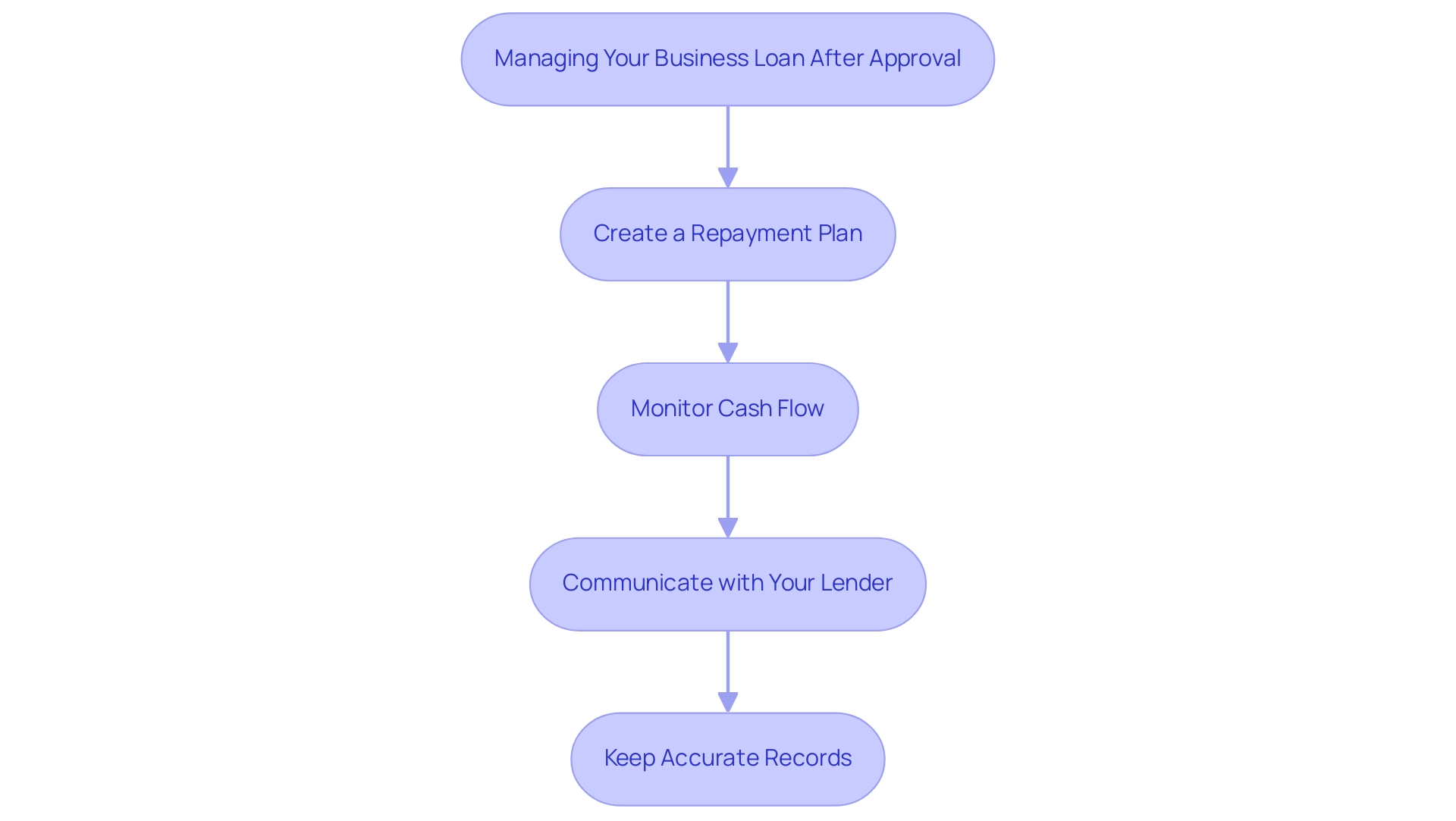
Taking the Next Steps Towards Securing Your Business Loan
With a solid understanding of the financial borrowing environment, it’s time to take decisive action. Start by thoroughly evaluating your financial requirements; this will assist you in choosing the most appropriate types of credit available. In 2025, the average duration required to obtain Australia business loans has been optimized. Numerous providers now offer swift online application procedures that can yield replies in as little as four working hours.
This efficiency underscores the importance of being well-prepared.
Next, conduct diligent research on potential lenders. Understanding their offerings and requirements can significantly impact your application success. Statistics indicate that many small businesses enter the financing application process with low gearing, a trend that has declined over the past decade, affecting their leverage.
Additionally, it’s noteworthy that the average loan amount is lowest for the computing sector, which accounts for only 1.77% of all applications. Therefore, ensuring your monetary documentation is meticulously prepared is crucial. This includes monetary statements, business plans, and any relevant tax documents.
To further enhance your chances of success, consider scheduling a free personalized consultation with Finance Story’s Head of Funding Solutions, Shane Duffy. This 30-minute meeting can offer customized monetary strategies and insights into crafting refined loan proposals that satisfy creditor expectations. Expert insights suggest that engaging with financial advisors or brokers can provide invaluable support during this journey.
They can help you navigate the complexities of the application process and tailor your approach to meet lender expectations.
As highlighted in a recent analysis by ASIC, small enterprises that have entered restructuring plans have shown resilience, with many successfully resuming operations post-restructuring. This case study illustrates the potential for recovery and the importance of strategic financial planning.
As Jon Sutton, CEO of ScotPac, emphasizes, "We really need the SME sector to be firing on all cylinders." As you prepare to apply for Australia business loans, consider the next steps:
- Refine your plan
- Ensure your credit history is in good standing
- Gather all necessary documentation
By taking these proactive measures, you can enhance your readiness and increase your chances of securing the funding you need to propel your business forward.
Remember, the right preparation not only boosts your confidence but also positions you favorably in the eyes of potential lenders.
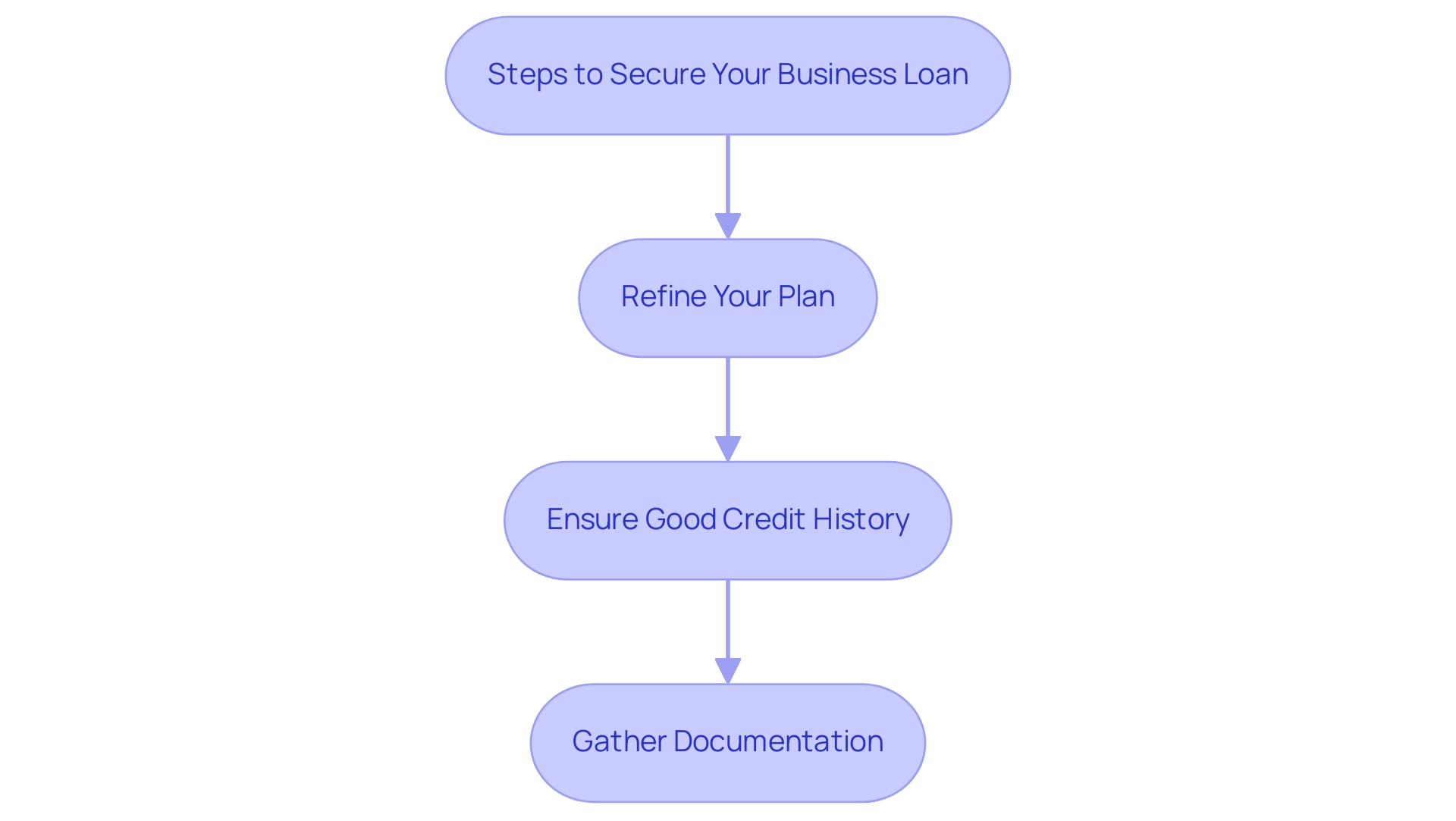
Conclusion
Understanding the intricacies of business loans is vital for small business owners seeking to secure the necessary funding for growth and sustainability. This article provides a comprehensive overview of various loan types available in Australia, including:
- Secured loans
- Unsecured loans
- Lines of credit
- Specialized options like equipment financing and SBA loans
Each type serves distinct needs, highlighting the importance of selecting the right financing option based on specific business circumstances and goals.
The application process for business loans can be daunting. However, thorough preparation can significantly enhance the chances of approval. By conducting a detailed assessment of financial needs, gathering essential documentation, and crafting a robust business plan, entrepreneurs can present compelling cases to lenders. Furthermore, understanding the role of credit scores and actively managing them can lead to better loan terms and conditions.
Common challenges, such as poor credit history and insufficient documentation, can be navigated with proactive strategies. Engaging with financial experts like Finance Story can provide tailored support, ensuring that small business owners are well-equipped to tackle these hurdles. Ultimately, making informed decisions and selecting the right lender is crucial for fostering a successful borrowing experience.
As the economic landscape continues to evolve, staying informed about trends in business financing will empower small enterprises to leverage funding effectively. By prioritizing strategic financial planning and maintaining open communication with lenders, business owners can not only secure financing but also position their businesses for long-term success. With the right tools and knowledge, small businesses can thrive, contributing to the broader economic growth and resilience of the community.




